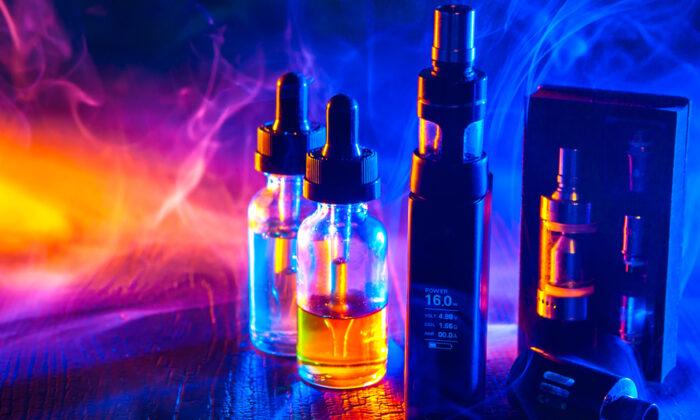Electronic cigarettes (e-cigarettes), better known as vapes, seem to be on the path of decline. After a series of regulations and market takedowns by the Food and Drug Administration (FDA), media reports of adverse effects, and lobbying by legislators and health advocates, the demand for e-cigarettes has fallen.
In July 2022, FDA banned JUUL products, a popular vaping brand that is a hit with smokers as well as non-smoking young adults and teenagers alike. This received controversial responses of support and backlash by the public, though the FDA later placed a pause on the ban, their action caused damage to JUUL’s image, and likely to the culture of vaping, which the company once broadly represented.
JUUL was particularly well known for selling concentrated e-cigarette nicotine cartridges that gave smokers a good kick of nicotine and got inexperienced teenagers hooked.
At the peak of its popularity in 2019, the company JUUL represented the craze for e-cigarettes with 75 percent of the e-cigarette market share in the United States.
Though many health advocates condemned JUUL for “taking a page” from Big Tobacco by launching market campaigns appealing to younger people, that had been mostly speculation. When JUUL sold 35 percent of its stock to Altria (Big Tobacco) in 2018, even though it was not (and still is not) public on the stock exchange, it gave evidence to health advocates’ argument that JUUL is another Big Tobacco company.
The decline of JUUL, the central player of e-cigarettes, seemed to signal the fall of e-cigarettes.
It has not only driven non-smokers to fear health implications, but also led some smokers to think that vaping is worse than smoking, despite long-term consensus among health experts that vaping was safer than smoking. The authors claimed that this incorrect information will cause 450,000 life-years to be lost by 2070 due to smokers not quitting smoking by shifting to e-cigarette use.
This raises the question, is the e-cigarette seeing the end of its glory days and becoming a thing of the past?

Smoking Versus Vaping
Is vaping safer than smoking?Prior to the EVALI reports, most research studies and health experts would have answered “yes.” E-cigarettes have considerably less harmful chemicals than combustible cigarettes and the educated guess is that they are comparatively safer.
In an average combustible cigarette, there are around 600 chemicals, and when combusted, over 7,000 chemicals are produced, of which around 70 are known carcinogens.
Some examples include acetaldehyde (used to make perfumes, plastics, and dyes), aromatic amines (in hair dyes and car exhausts), arsenic, benzene (in gasoline), beryllium (a toxic metal), 1,3–butadiene (a hazardous gas), cadmium (a toxic metal), chromium (a metallic element), cumene, ethylene oxide (in antifreeze), formaldehyde (preservative and disinfectant), nickel (a metallic element), polonium-210 (a radioactive chemical element), polycyclic aromatic hydrocarbons (in coal and petrol), tobacco-specific nitrosamines, and vinyl chloride.
Health experts argue that e-cigarettes are safer as they contain less chemicals that are also less harmful. The chemicals in e-cigarettes include nicotine, propylene glycol, glycerin, flavorings, and other chemicals. These chemicals are generally deemed to be safe for human use, yet no one is certain of their effects when inhaled over the long-term.
Some studies have also detected flavoring agents such as diacetyl (a chemical linked to lung disease), volatile organic compounds (a health concern if in high concentrations), as well as heavy metals such as nickel, tin, and lead in the e-liquids.
Research on the health implications of e-cigarettes has also been limited.
A Smoking Cessation Product?
E-cigarettes are currently not approved by the FDA as therapeutic products for smoking cessation, though some studies have shown that smokers have stopped smoking by making the switch to e-cigarettes.The credited inventor of e-cigarettes is a smoker and pharmacist named Hon Lik. Lik developed e-cigarettes with the noble intentions of improving smoking cessation after his father, who was also a heavy smoker, passed away from lung cancer.
Lik believed that creating a product that mimicked the smoking experience would help him quit. He has since become a dual user of both cigarettes and vapes. The ciga-likes that he first developed have also gone through evolutions in design as well as purpose, transitioning from a tool for smoking cessation to a niche device for pleasure among former smokers and young people.
Lik never managed to quit smoking, and instead became a dual user, meaning that he both smokes and vapes.
The study found that vaping in the context of therapeutics increased smoking cessation but this was nullified in studies that examined vapes as a commercial product.
This finding was similar to studies on FDA-approved smoking cessation products. When the approved products are available as a prescription, they are associated with improved smoking cessation; this association was lost when they became available as consumer products.

JUUL Labs and Teenagers
JUUL, short for JUUL Labs, has been labeled as the iPhone of smoking. Marketed as a product to help smokers quit, it created ripples in the U.S. e-cigarette market since its launch in 2015.Most nicotine solutions in the e-juice then were freebase nicotine solutions. These made e-liquids alkaline and corrosive; manufacturers therefore could not increase nicotine potency without increasing alkalinity.
Alkaline vaping liquids give vapers sore throats and coughs, and potency therefore stayed at around 1 to 2 percent nicotine to prevent discomfort.
However, nicotine salts provided an alternative to the traditional freebase solutions. By putting an acid and a base together, the nicotine salt liquids were a neutral solution that allowed manufacturers to add more nicotine without compromising the vaping experience.
The vape juice in JUUL pods reached 5 percent nicotine, which is the same as average cigarettes, giving users greater satisfaction and also a higher risk of addiction.
The vapes came in flavors of Virginia tobacco, classic tobacco, mint, menthol, cool cucumber, mango, crème brulee, and fruit. Mint and fruit flavors were particularly popular with teenagers.
The product was a hit with smokers, as well with teenagers and young adults. Prior to JUUL’s release, some teenagers also vaped on and off, but the high nicotine dosage in JUUL had many teenagers and young people hooked, using the product daily.
JUUL’s popularity among teenagers was unprecedented; high school students used the term “juuling” synonymously with “vaping.” School toilets were adorned with images of the JUUL e-cigarette mod pods.
In 2015, 16 percent of high school students were using e-cigarettes; this number jumped to 27.5 percent in 2019 at the peak of JUUL’s popularity.
At JUUL’s peak, the company made up 75 percent of the U.S. market share.
However, its rapidly growing popularity also led the company to face increasing public scrutiny. Its fall from grace came from the move of marketing the product on social media for their launch, attracting attention from the younger population.
To quickly increase its publicity, JUUL hosted launch parties in New York and Los Angeles, the two most influential cities in the United States. As a trendsetting event, many influencers and socialites were invited to take photos while using JUUL’s vape. The best photos had a chance of appearing in Times Square. Over the coming weeks, hundreds of New York and Los Angeles influencers were also given free JUUL products.
Social media was awash in photos of young, attractive people holding drinks and puffing on Juuls, their photos hashtagged #Vaporized and #LightsCameraVapor. Influencers on social media were also hired to post photos while vaping JUUL and hashtagging JUUL as they depicting the product as trendy, popular, and full of sex appeal.
This successful marketing campaign that made JUUL’s name on social media was both a boost and a blow to the public image of the company.
Many health lobbyists alleged that JUUL targeted minors from the beginning. The most powerful evidence was that JUUL marketed extensively on social media, a place where teenagers and young adults frequent. Many states have also won successful lawsuits against JUUL using their social media marketing campaign as evidence.
JUUL has vehemently denied that it targeted teenagers. Though the company’s intentions behind the glamorous marketing campaign remain unknown, the company’s loyal teenage following of long-term vapers was seen as a verdict for guilt itself.
Health lobbyists were always concerned about the health impacts nicotine vapes would have on teenagers, and their concerns were legitimate.
Addictive chemicals such as nicotine are very risky for teenagers. Since their brains are still developing—particularly the regions responsible for decision making and logic—nicotine can impede neurodevelopment, placing them at higher risk for addiction.
Some teenagers indeed became addicted, and even progressed to riskier drugs. Some of them started vaping tetrahydrocannabinol (THC), the psychoactive chemical in marijuana, after buying them from dealers.
Health ramifications soon surfaced.
Beginning May to June of 2019, cases of emergency department visits due to e-cigarettes and vaping (“e-cigarette, or vaping, product use associated lung injury,” or EVALI) started to emerge. The cases peaked in September with over 200 cases a week.
Anecdotal reports of teenagers needing lung transplants or experiencing nicotine addiction also started entering news headlines.
Hergenreder started off vaping JUULs to fit in, but he soon got addicted and went from occasional puffs to using one pod (the equivalent of one pack of cigarettes) and a half every day or every day and a half. He later added THC to his e-liquids, and soon started developing uncontrollable shivers. Then he started to vomit.
After being referred to a few pediatricians, one doctor finally connected his symptoms to his vaping THC,;however, the physical damage was done and Hergenreder would no longer be able to play on the school’s varsity sports team.
The family has since filed a lawsuit against JUUL and the local gas station that sold him the vapes as they did not check him for identification. Since Hergenreder was not an adult, it would be illegal not only for him to buy vapes but also for those who sold vapes to him.
The agency linked almost 82 percent of the hospitalizations with users vaping e-liquid that contained THC. Some 33 percent also reported exclusive-use of THC-containing products.
However, the media has placed emphasis on stories of injured teenagers who were introduced to vapes through JUUL, rather than focusing on the reality that the majority of these injured teens added THC to their regimen.
This dealt another blow to JUUL, and particularly the e-cigarettes.

Ban or No Ban
The alarming cases from EVALI drove legislative action against vapes that would quash their use by the public.However, the media and legislators were so focused on preventing young people from becoming addicted that many lost sight that there are also other consumers who use vapes: smokers.
For many years, the major discourse of e-cigarettes was this tug-of-war between “prevention of youth vaping versus the potential for e-cigarettes to help adult smokers to quit,” the authors of the FSFW report wrote.
However this discourse is now polarized, with the major contributors to the conversation focusing on teens while they disregarded the possible benefits e-cigarettes have in quitting smoking.
The legal age for purchase of e-cigarettes has also been raised from 18 to 21 years old.
Though JUUL was not responsible for most of the lung injuries and hospitalizations, its popularity among teenagers has caused irreplaceable damage to the brand’s image.
Health lobbying groups such as the American Lung Association used JUULs synonymously with teenage vaping. Though other brands such as VUSE—the second biggest e-cigarette company and owned by British American Tobacco—were also popular with teenagers, they faced far less backlash.
The American Lung Association celebrated and praised the FDA for its decision as long overdue, singling out JUUL as a key driver behind teen vaping.
However the FDA’s National Youth Tobacco Survey in 2021 showed that the leading e-cigarette products are now Puff Bar (26.8 percent) and Vuse (10.5 percent), with JUUL only making up 6.8 percent of the teenage market.
There were also significant numbers of voices dissenting from the order. Guy Bentley, the director of consumer freedom at the Reason Foundation, was one of the dissenting voices.
The EVALI and targeted campaigns against JUULs and vaping did not just reduce vaping among teenagers. Health concerns from vaping also spilled into demographics that benefited from vaping, including smokers.
Since EVALI, vaping in teens has reduced to 3.6 million, and demand has shrunk for e-cigarettes altogether.
“The use of nicotine-containing electronic- or e-cigarettes has divided the tobacco control community along a spectrum from fervent opponents to enthusiastic supporters,” the authors of the FSFW-funded report wrote.






